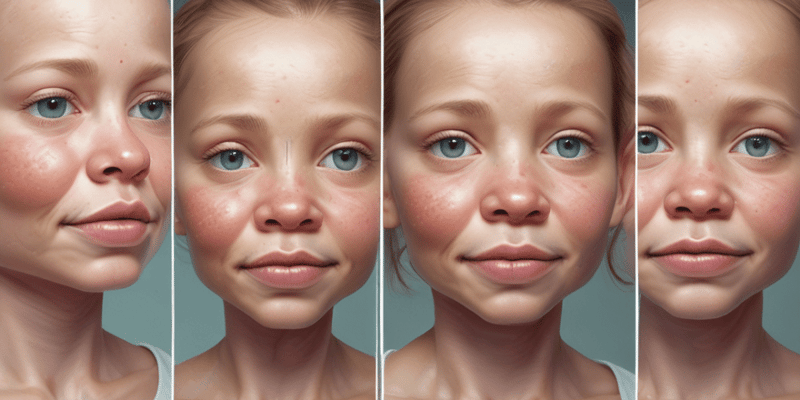Podcast
Questions and Answers
What is a common characteristic associated with a submucous cleft palate?
What is a common characteristic associated with a submucous cleft palate?
At what minimum age is primary repair surgery typically considered for a cleft lip and/or palate?
At what minimum age is primary repair surgery typically considered for a cleft lip and/or palate?
Which of the following is NOT a criterion for performing primary repair surgery?
Which of the following is NOT a criterion for performing primary repair surgery?
What is considered a microform cleft?
What is considered a microform cleft?
Signup and view all the answers
What aspect of cleft lip and palate generally requires orthodontic assessment?
What aspect of cleft lip and palate generally requires orthodontic assessment?
Signup and view all the answers
Study Notes
Cleft Lip and Palate Development
- Develops between weeks 6-12 of gestation
- Fusion of facial processes occurs during this time
Types of Cleft Lip and Palate
- Cleft lip with or without cleft palate
- Cleft palate only
- Submucous cleft palate
Causes of Cleft Lip and Palate
- Multifactorial etiology
- Genetic predisposition
- Environmental factors
- Maternal smoking
- Alcohol consumption
- Certain medications
- Folic acid deficiency
Epidemiology
- More common in males than females
- Higher incidence in certain ethnic groups
- Rates vary geographically
Microform Cleft
- Dent in the lip and a scar from the lip to the nostril
- May affect muscle tissue and require surgery
Submucous Cleft Palate
- Midline deficiency or lack of muscular tissue
- Often associated with a bifid or cleft uvula
Problems Associated with Cleft Lip and Palate
- Feeding difficulties
- Speech impairments
- Ear infections
- Dental problems
Dental Problems
- Missing teeth
- Malocclusion
- Tooth decay
- Gum disease
- Delayed eruption of permanent teeth
Orthodontic Issues
- Overjet
- Crossbite
- Open bite
Prenatal Diagnosis
- Ultrasound
- Amniocentesis
Management of Cleft Lip and Palate
-
Birth:
- Feeding support
- Medical evaluation
-
10 weeks:
- Nasal obstruction assessment
- Ear, nose, and throat (ENT) evaluation
-
3 months:
- Lip repair surgery
- Speech therapy referral if required
-
1-3 years:
- Palate repair surgery
- Speech therapy
- Dental evaluation
- Hearing assessment
- Psychological support
-
3-6 years:
- Further dental evaluation
- Dental treatment as needed
- Speech therapy ongoing
-
8-9 years:
- Orthodontic evaluation and treatment
- Speech therapy if needed
-
10 years:
- Secondary palate repair surgery
-
12-14 years:
- Orthodontic treatment continued
- Speech therapy as needed
-
17-20 years:
- Orthognathic surgery (if necessary)
- Dental work as needed
Surgery for Cleft Lip and Palate
-
Primary Repair Surgery:
- Performed when the child weighs at least 10 lbs
- Haemoglobin level of at least 10g
- White blood cell (WBC) count of no more than 10,000
- At least 10 weeks old
Orthognathic Surgery
- Corrects jaw position and alignment
- Performed in late adolescence or adulthood
- May improve facial appearance and function
- May involve jaw bone repositioning and reshaping
Studying That Suits You
Use AI to generate personalized quizzes and flashcards to suit your learning preferences.
Related Documents
Description
This quiz covers the development, types, and causes of cleft lip and palate. It also addresses epidemiology, associated problems, and the concept of microform clefts. Test your knowledge on this important topic in craniofacial abnormalities.



